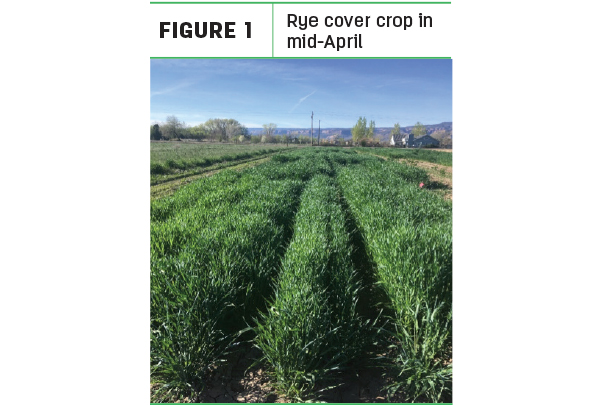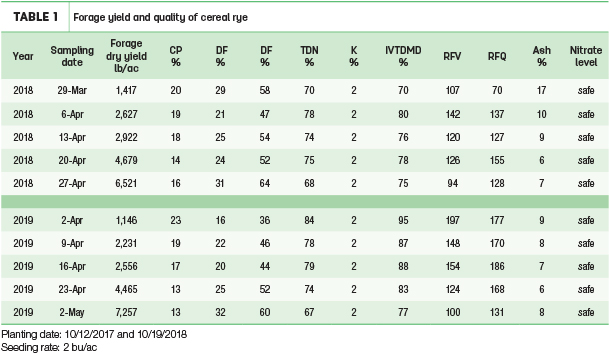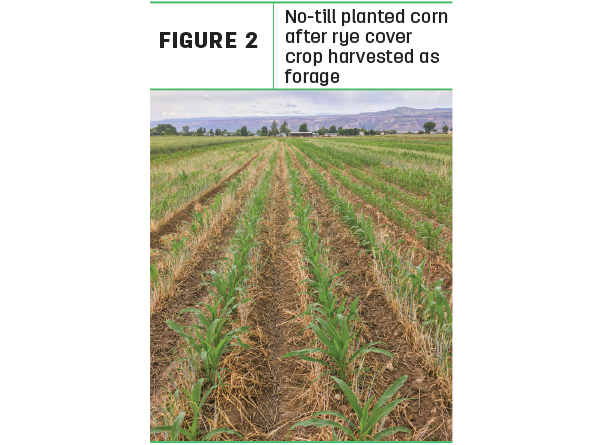The western Colorado climate is favorable for growing cereal rye, which can be planted during seasonal fallows between harvest and planting of cash crops in irrigated cropping systems. This can happen after pinto bean harvest, silage and grain-corn harvest, or sweet corn harvest. Early planting (early to mid-October) allows rye to grow and produce a substantial amount of biomass by the end of April (Figure 1), when it can be used as forage in various ways (pasture, greenchop, silage, hay, etc).

Although beneficial, the cover crop biomass can be troublesome in furrow-irrigated fields and can create problems in irrigation operations of the following cash crop, so using the rye biomass as forage helps alleviate this problem.
We conducted several research trials at the Western Colorado Research Center to evaluate yield and quality of cereal rye for forage production. Our results showed that rye cover crop planted from Oct. 10 to Oct. 21 after pinto bean harvest can produce around 6,000 pounds of dry biomass by the end of April. On average, rye produced over 1,200 pounds per acre of dry matter every week from March 27 to April 29 (Table 1).

Forage relative feed value (RFV) and relative feed quality (RFQ), however, followed a declining trend as plants senesce. Specifically, crude protein reduced and fiber (acid detergent fiber and natural detergent fiber) increased as harvest was delayed. Our research results showed that around April 20 is the best time to harvest rye cover crop to obtain high yield and high quality simultaneously.
Rye cover crops can also be grazed. Farmers in western Colorado had a positive experience with grazing rye cover crop. Grazing can start as soon as March 20 and extend for 30 days or so. Nitrate levels in rye biomass were in the safe range at all sampling dates in our two-year study. In soils with high potassium (K) levels, rye can uptake and accumulate excessive K, which can limit its suitability for dairy rations. In our study, however, K concentration in rye biomass never exceeded 2% (dry matter basis).
After cover crop termination in late April, corn can be no-till planted without needing additional soil preparation (Figure 2).

Rye regrowth can be easily controlled by using glyphosate before or after corn planting. Nitrogen (N) management for corn after rye cover crop, however, needs some adjustment. In this system, a higher amount of basal N is usually needed to ensure sufficient nitrogen availability for corn growth at the early stages. This greatly depends on soil conditions and can vary significantly from field to field. A research trial is underway to evaluate the corn N requirement after rye cover crop harvested as forage.
This dual use of cover crop not only provides soil benefits but also produces cheap forage in early spring that could create a significant economic return. Use of cover crop biomass as forage may not only offset the cost of cover crop planting and management but also can create a significant net return that varies from location to location. One of the major benefits of this approach is that soil is protected by rye cover from erosion during winter. Additionally, despite the fact that cover crop aboveground biomass is removed from the field, root and crown biomass will still remain in the field, lending to carbon inputs and increasing soil biological activity. ![]()
Reza Keshavarz Afshar is a research scientist at Western Colorado Research Center, Colorado State University. Email Reza Keshavarz Afshar.









